Interviews, People, Surf cultureTwo’s Company: Tandem Surfing
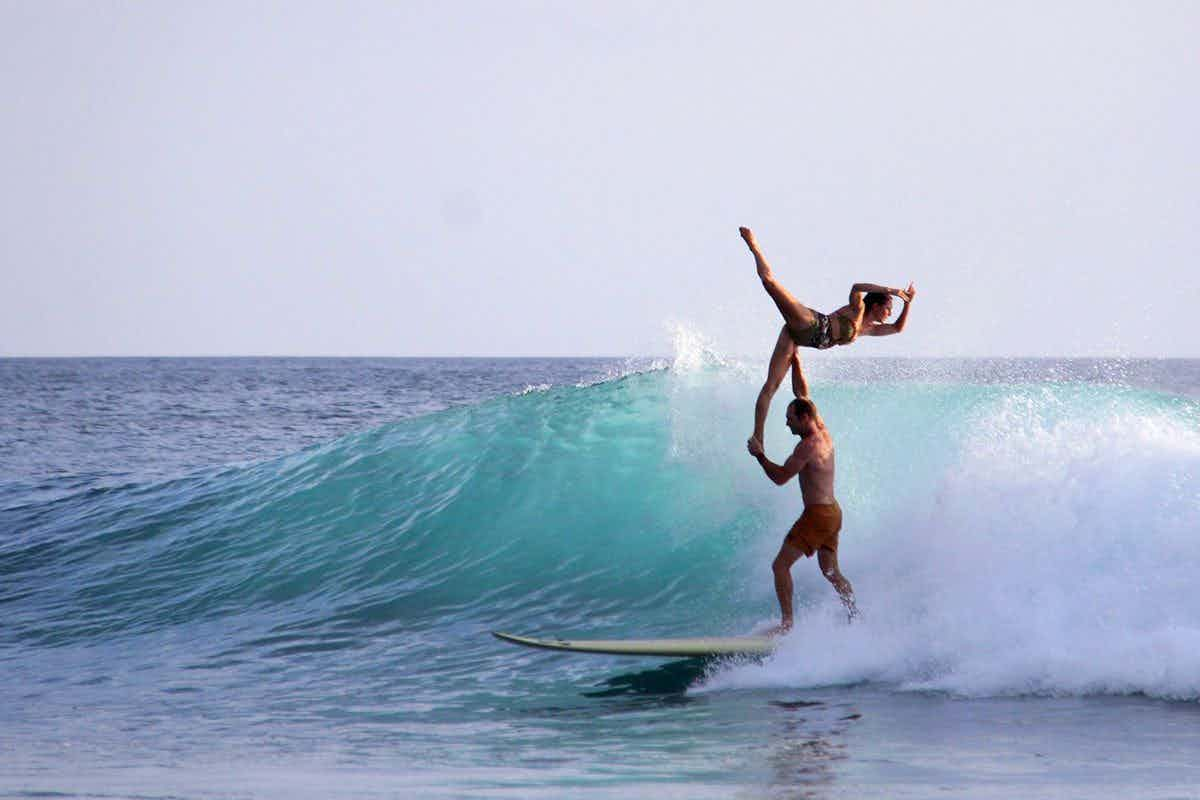
Surfing is, for the most part, an individual sport. It is just surfer, surfboard, and the wave; there is no team or opponent to play against. But, at one time or another, many surfers will have shared a surfboard and tried riding tandem; perhaps on a small summer’s day at their home break when messing about with friends, jumping across to each others’ boards, and any surfer who’s ever worked as a lifeguard will have had to train to use a rescue board and return a casualty to shore on it. But tandem surfing extends beyond these rare functional or novelty moments, and the act of sharing a surfboard and the experience of riding a wave has a long and rich history.
Fred and Aurelie (Lily) Branger are a husband and wife tandem team from Australia’s Sunshine Coast who share their love of tandem surfing with others through events, exhibitions and clinics. Surf Simply caught up with them recently to find out a little more about the history of tandem, what’s involved, and what makes it so special.
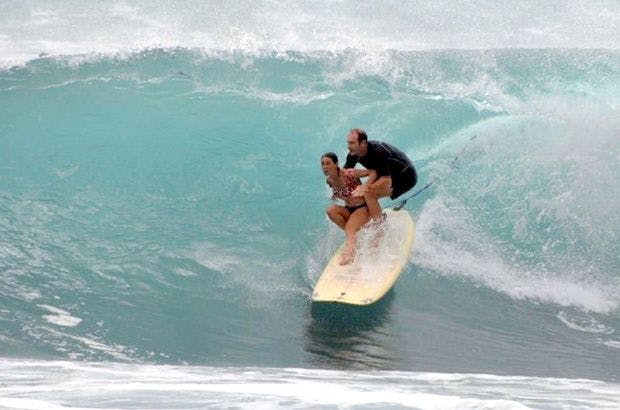
Can you tell us a little about the history of tandem surfing?
Fred: The History of Tandem surfing is something that Lily and I are very passionate about, and that we find very interesting. One of our main motivations in surfing and teaching tandem is to keep that tradition alive. As far as we know, Hawaiians surfed tandem consistently before white settlement. Tandem is probably one of the local practices that did not fare well with the missionaries who viewed the surfing as immoral.
When surfing experienced a revival with the Duke and the Waikiki Beach Boys at the turn of the century, the story goes that the Beach Boys took tourists out regularly (usually pretty members of the opposite sex). They soon figured out it was easier to steer the board with the girl in their arms or on their shoulders, plus it made for great photo opportunities. Also, in the 20’s people often gathered at beaches around the world (particularly Waikiki and Muscle Beach in California, but also Bondi Beach in Australia) to do acrobatics and gymnastics. It is likely that the close proximity of the surfers and acrobats leads to more acrobatic lifts being done on surfboards. At some point, Californian surf meets started including a tandem division and it was common for the best surfers to take part in the tandem and race divisions to claim the “King of the Comp” honours. Pete Peterson, a very successful Californian competitive surfer from Santa Monica was at the forefront of that scene from the 30’s to the 60’s and was a key figure in furthering and keeping the art of tandem surfing alive. Barrie Algaw, a very talented acrobat, won the Makaha World Tandem surfing Championship with him in 1966 and went on to tandem surf with husband Steve Boehne. With the popularity of the shortboard in the 70’s and 80’s, tandem surfing would have probably been abandoned if it had not been for the Boehnes, a few Hawaiian Beach Boys and Makaha surfers keeping the tradition alive.
How did you both get into it?
Fred: I got into it in 2001 when I lived in San Diego, California where I went to University. I worked as a surfing instructor for Bob Edwards (Kahuna Bob) in Encinitas. He was a tandem surfer and we often tandemed with the students. The Coalition Club Contest in California still has a tandem division and a friend and I started learning more lifts in order to compete. We learned a lot from Steve and Barrie Boehne in San Onofre.
Shortly after moving back to France in 2007, I met Aurelie (Lily) who lived in Paris. She was a skateboarder and snowboarder getting more and more into surfing. She had done gymnastics as a teen and was super keen to try tandem. We started then, quickly married and eloped to Australia where we’ve been living since November 2008.
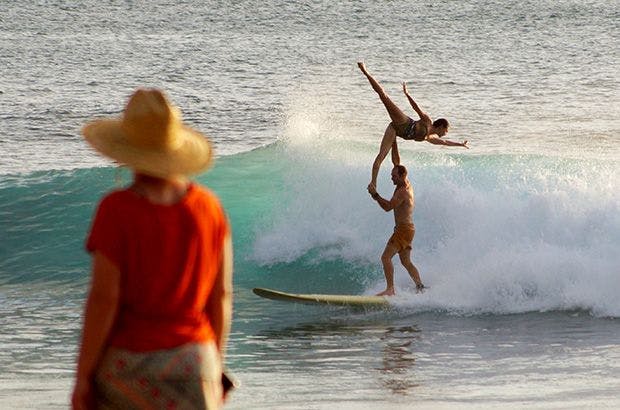
Lily – what’s the view like from up there when you’re being held backwards or upside down? It must be very different to what most other surfers see. What’s the reaction of other surfers in the line-up when you glide past? Do you notice it, or are you too focussed?
Lily: The view is very nice. I can look at the tail of the board with the rolling wave covering it. When I am upside down, I try to maintain an awareness of what the wave is doing in case of an emergency dismount. Some set up positions are on one leg, watching over Fred’s shoulders, and I have to keep the balance until we have a stable opportunity to jump and lift. Thanks to tandem practice, I get to ride switch, backward stance or recover from funny one-legged off-balance positions easily when I surf on my own.
Sometimes, the surfer on our inside tells us to join him on the ride and I can look at him and smile while we share the wave. This is a very unusual situation for them and they love it! Often, most of the other surfers in the line-up are seeing tandem for the first time and they stare at us while we ride, thinking “What was that?” It’s frequent to hear cheering as we ride and nice words on our way back out.
Lily – is it very much more difficult to maintain your balance on a wave as opposed to a static hold on dry land?
Lily: I am very focused on the wave and keeping in position well. On land, I can get more distracted. We don’t try new lifts on the board until they are rock solid on the sand.
When I have the position well imprinted in my head, I will just do it and smile!
If we can’t hold a lift, this is usually because our timing is off, the hand position is not good, a section hit us or the wave disappears. For some lifts, the balance is not the same when in motion and so we have to modify our position for surfing.
The shape and size of waves changes our choice of lift. We have the stable lifts for bigger or faster waves, which are solids while Fred turns. When the wave is slower and we just have to go down the line, we can do the tricky poses like a split over Fred’s head. Shallow waters require a choice of low lifts. Quick rides can allow only fast set up/dismount moves.
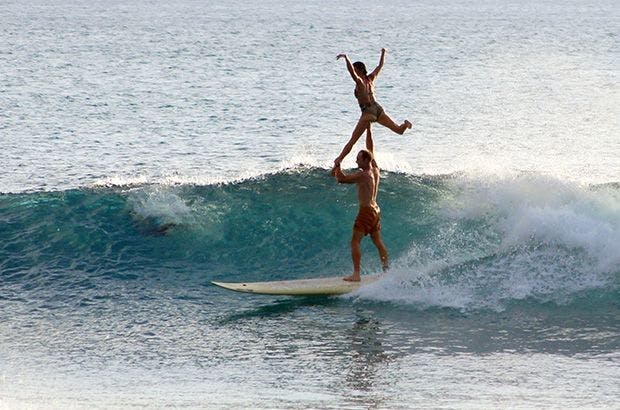
When you’re both surfing (not doing a lift), who does the surfing?
Fred: Being at the back and heavier, I have the most control of the board, but in order to perform good surfing manoeuvres it’s very important for Lily and I to move as one and for her to anticipate the manoeuvres as I do. It really helps that she is a good surfer herself. Our stance is very close and we lean forward and back on each other. When doing a cut back for example, I initiate the turn by pulling her back towards me and opening both our shoulders, but, to wrap it around, Lily follows through and applies the necessary front foot pressure for a nice carving turn. Also, when grabbing the rail backside on a hollower section, Lily grabs the rail and I hold her so, in that situation, she has most of the control. Also, Lily is quite involved in selecting waves, I tend to be a bit impatient sometimes whilst she’s a bit more cool-headed!
Fred – how difficult is it to concentrate on surfing whilst lifting Lily?
Fred: It depends on quite a lot of factors: the conditions, the type of waves you are surfing, and the type of lifts you are attempting. When the waves are very predictable and peel nicely, the surfing is not complicated and is a bit on automatic (going straight on a big board in easy surf is not technically demanding). Fast point-waves like the ones that we get here in Noosa, Byron or on the Gold Coast require a lot more skill and concentration than one may think as it can section and hollow out in an unpredictable way. The key with tandem surfing is to only attempt lifts in conditions that you feel comfortable in, but when you do, surf with confidence. Second guessing yourself and tandem surfing do not mix very well.
When competing, what’s the scoring emphasis on lifts and the “acrobatic” side of tandem surfing as opposed to the actual surfing, because you’re doing turns and riding the waves properly?
Fred: The competition judging system ranges the lifts from easy to difficult. The more difficult ones you do, the more points you can have. If you are focused on the surfing manoeuvers, only easier lifts allow you to be radical. If you don’t mind sacrificing your surfing score, you can go straight and set up crazy acrobatic moves, and obtain a decent lift score. We think that the new challenge is to perform higher lifts while doing turns. This is what we are working on: stepping outside our comfort zone and holding hard poses on turns.
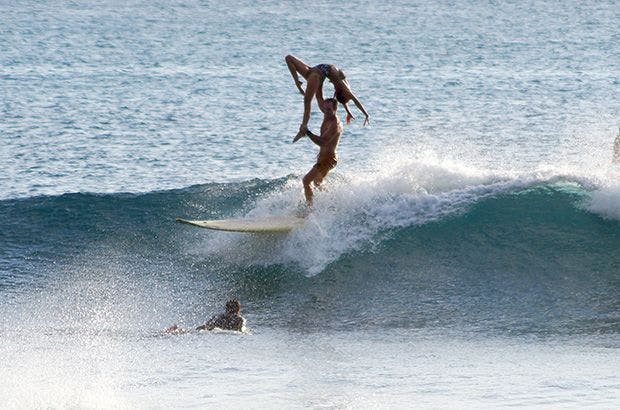
Is the tandem surfing scene a tight-knit community, or are tandem couples few and far between?
Lily: We feel very close to our local tandem surfing friends. We organize weekly practices and watch each other kids while we surf. During those gathering, we share boards, take pictures, spot the acrobatic moves, cook food and grow our friendship.
The international tandem surfing scene is very small. Probably less than 200 people have a tandem board and only a third would use it on a regular basis.
We are keeping in touch with overseas couples via social media. Competitions and exhibitions at surfing festivals are good opportunities to get together and travel to surf different breaks. Connections become friendship but unfortunately tensions can happen too. We like to meet tandem surfers from everywhere, to share our stories and organize some practice time.
Last December, we travelled to Oahu and we surfed the amazing Makaha break along with some of our Hawaiian friends. We like to host travelling tandem surfers and show them around our part of the world too.
How many competitive teams and couples would you estimate there to be?
Fred: There are maybe only 30 competitive teams in the whole world. The biggest contest organized in 2015 had just 16 teams. Regional contests will usually gather 4 to 8 teams.
Does tandem surfing exist much outside of competition, as other forms of surfing do?
Lily: Sure, there are many tandem surfers outside competition. We have taught tandem to dozens of people since we met. Most of the time, they are happy to learn some easy lifts and just have fun. The competitions can be quite intimidating because of the high acrobatic skills, and the judging doesn’t always sound fair. We are personally not involved much in competitions, since taking part in exhibitions produces more graceful images and it is safer.
Who tandem surfs? We can count all the Hawaiian beach boys and most surfing instructors. Tandem is a great way to bring along a beginner in the surf on a small day. Dads and Mums around the world often take their little ones on a board in the summer. For small and light partners, a thick longboard or any 9 foot plus SUP will be good.
We love this GoPro video of Daize Shayne Goodwin surfing with her young son Given at Waikiki:
Tandem is also a safe option to invite people with disabilities to ride waves. Fred has surfed with Down syndrome kids in the past and they were stoked! A couple of years ago, he had the opportunity to tandem with Shona, a friend who lost both of her legs in a car accident 10 years before.
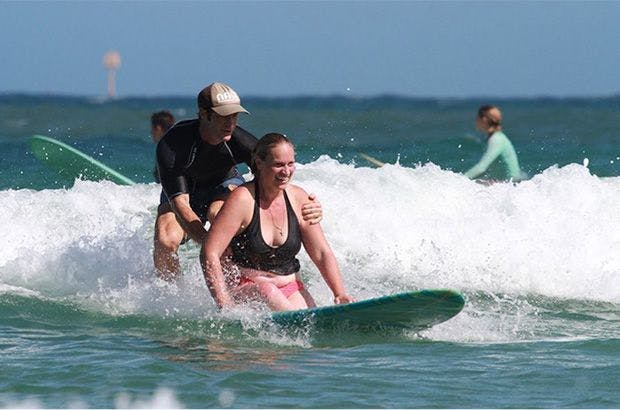
Almost all the tandem surfers we know have similar stories.
You will find great information about the topic in this webpage: http://www.rideawave.org/tandem_surfer.php
How well does dry-land practice prepare you for lifting whilst riding a wave?
Lily: Land practice is essential. In order to be done in a safe way spotters should be used. Pool practices are common as well. When we wish to try new moves, we need the help from other tandem surfers or skilled acrobats from different backgrounds.
It is an awesome experience to train with ballet dancers, circus performers, yogis and gymnasts. We love the creative part of making original shapes, inspired by pictures of professional performers. Developing unusual coordination skills is a very interesting challenge. The process of learning and working out the potential of our bodies is a journey which allows us to do moves that we never thought we could do in our lifetime.
Tell us about the surfboard that you use – do you have a quiver for different conditions? Could a couple looking to get into tandem use an SUP now that they’re so common and accessible?
Fred: We only use one board, which is a “performance” one. It is hand-shaped by Tully St John from Laguna Bay in Noosa Heads. The dimensions are 11’ x 27” x 4”. We should have a bigger one for small surf.
A tandem board is typically 12 feet long and 26 inches wide. It needs to have a good nose lift because of the extra weight in the middle of the board to avoid nose diving. Both of the surfers will be paddling, so the board should not be wider than 29 inches. Some SUP with a gunny shape are perfect. You have to wear a leg rope the length of the board. This is a big and fat performance longboard and it’s reasonable for other surfers to be worried about it: riding safely, picking friendly waves and keeping the board away from the impact zone will help you to be welcomed in the line up. The girl doesn’t wear a leg rope though: her safety comes first. You have to wipe out together: she is in your arms and you push the board away. In case you get caught by a set, she has to dive under the waves, swim slowly and keep her energy until you come back to pick her up (as quickly as possible).
You can dive a little deeper into the world of tandem surfing and find out more at www.nalu-surf.com, or catch Fred and Lily in action when they put on a tandem surfing display as part of the Noosa Festival of Surfing on the afternoon of Saturday, March 5th at First Point, Noosa.